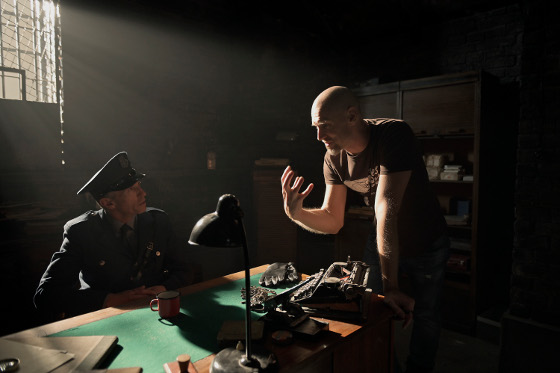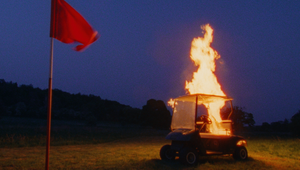
Your Shot: The Festive Film Magic of Lidl’s Christmas Behind Bars

Misko Iho describes the aesthetic of his Lidl Christmas ad as “grim but romantic” and there’s no better way to describe the film. Created for the supermarket by Folk Finland and directed by Misko through Directors Guild Helsinki, ‘The Cell’ tells the gripping story of Christmas in a tiny remote prison, exploring the nuanced relationship there between an inmate and his prison guard. At this time of year we’re up to our knees in cliches, but Misko’s is one of the stand-out ads of the season, giving us something genuinely different.
LBB’s Alex Reeves caught up with the Finnish director to find out how it all came together.
LBB> What was your reaction when you first read the script?
Misko> I love extraordinary stories that take us away from the mundane, and I’m also a fan of prison films, so I was hooked after the first read.
I liked the simple structure of the script and the opportunity to work on the silent friendship of these two characters stuck in the same desolate prison, just on the different sides of the bars. I also like the timeless and universal message of camaraderie that comes across from the story. Folk Finland indeed crafted an excellent script that needed very little adjusting. Also, kudos to Lidl for opting to go with a bit different Christmas story.
LBB> What were your first thoughts on how you would bring the story to life?
Misko> I felt that emotion was the key to this film, so even though there’s some lighthearted humour, I treated it as a drama from the get-go. I wanted the characters and their actions to drive the story, so it was important to keep the film visually grounded and keep the storytelling style simple.
I also wanted to spend some time establishing our location and introducing the lonely life of these characters while setting up the story; this way, the rest of the film would feel more powerful. It was nice to have enough time for some longer shots and adequate setup especially during the first half of the film.
LBB> Can you talk about the aesthetic? It's got a very confident 'look' to it - what were your ideas there? When and where is it set?
Misko> I’m a big fan of classic cinema and traditional storytelling, so I’m quite calculating when making movies. Captivating stories are important but I also enjoy visual beauty in films, so when directing, I try to achieve both. If the story represents the heart and blood of a movie, the aesthetic would be the rest of the body. Every artistic decision should, of course, support the story, but usually, I keep the camera on a dolly or a crane to be able to control its movement fully. For lighting, I like shadows and moody atmosphere. When outdoors, I give a lot of attention to the time and moment of the day and usually opt for low light if possible. I like to avoid anything average and paint a picture of the world that’s more interesting than the real thing, show the most beautiful or grim side of it.
Despite the opening shot being quite fantastic, I wanted the rest of the film to have a more grounded look. I love shooting with anamorphic lenses as they tend to bring organic qualities for the image especially when shooting digitally, but for this, my cinematographer Jean-Noël Mustonen suggested the classic Zeiss Super Speeds, which were perfect for the low light conditions and captured a straight and honest image while not being too sharp.
I also like to spend a lot of time in the colour grading, which I think is an essential part of the post production when considering the look of a film. For this, with my longtime colourist Henri Pulla, we decided to go with a quite neutral look, keep the palette suppressed and the shadows dark to emphasise the nature of the location. In the beginning, we also emphasised the contrast between the warmer tones of the guard’s desk and the bleak atmosphere of the cell.
The exact period of the story is debatable, perhaps these guys are stuck in the past, or it’s an alternative reality, but as a general guideline for the art, it takes place during the early 19th century. The roots of Lidl go as far back as the 1930s, so we are not even reaching. “Where?" is a better question, it’s clearly far from everything, expect Lidl; or should I say, Lidl is close to you whereever you are.
LBB> That opening shot is ridiculous but brilliant! Are there any prisons that actually look like that in Finland?
Misko> The opening shot was mostly the result of the talented wizards at Troll VFX. To help them, we scouted and photographed a real cliff, which Troll used as the basis for the view. We also built a miniature of the prison, which we used as a basic structure of the building. Troll then composited these elements together and added moving clouds, mist, birds, snow and other small details to make it look authentic and precisely like all the prisons in Finland. Troll also worked on the views outside the windows.
LBB> How about casting? How did you choose your prisoner and guard?
Misko> I trusted the story and tried to keep the casting grounded. We wanted to find actors who could portray these characters without any significant efforts, and I deliberately kept their performances minimalistic. This story is an excellent example of how actions speak louder than words, which is true as much in real life as in fiction.
I wanted the guard to have a very confident composure opposing the softer and older habitus of our prisoner. We needed memorable characters but avoided caricatures and funny faces. The story calls us to feel sympathy for the prisoner, so it was essential to find an actor who could portray the role of a long time convict without looking like a hardened criminal.
Our producer, Juha-Matti Nieminen, cast the net over Serbia, Germany, and England. We went through a ton of people, and eventually, we found our guard, Carl Wharton, from England. Our prisoner, Branko Jerinić, was a last minute entry and a veteran from the Serbian theatre, so we even had a natural juxtaposition there. Both inhabited their characters well and worked as a great pair, so there was only little steering I did to make things right. As they say, the most important job of a director when directing actors is to choose the right ones.

Misko giving his prison guard Carl some direction
LBB> What was the biggest challenge of the process and how did you overcome it?
Misko> I’m a big fan of shooting in real locations, but I had a very particular look in mind for the prison, grim but romantic, so from early on it was clear that we can’t find a real location that would match our needs, so we decided to build it. To ground the story, I also wanted it to look as real as possible, which is always a challenge when constructing a set. I did quite extensive research of prisons for the look and had great time re-watching all my favourite prison films like Papillon (1973), The Green Mile (1999), and The Shawshank Redemption (1994). We are certainly making an homage to some of these films.
To make our set realistic, it needed a lot of detail, while still keeping the basic structure of it simple. I had a great production designer, Aljosa Spajic, in Serbia where we shot this, who managed to hire us the same crew that had just worked on the remake of Papillon. Aljosa made several iterations of the prison in 3D to get the proportions, and even the materials, right before moving into construction. I also wanted the prison to look functional, so all the details and props we see would have a purpose. The set Aljosa and his team constructed was not only beautiful but 360, so it gave us total freedom to move around during the shoot, which was great.
Another challenge was the score of the film. We put a lot of effort with my composer Hannu Honkonen to find a melody that would live with the action and help to fortify the emotional structure of the story. We also wanted to keep the music as “small” as possible to support the desolate location and loneliness of these characters, but at the same time being careful not to make it too melancholy. Hannu did a great job of creating an original melody that checks all these boxes. I also felt it was essential to use real players to record the score, as real musicians will always bring an organic touch into the music blowing it to life.
LBB> Any parting thoughts?
Misko> I love the creative atmosphere that rises from a crew that's inspired by a great script; when everyone's excited to bring their ideas on the table and goes an extra mile, like in this project. That’s why I also love filmmaking.
Thanks to my crew for having my back; Lidl, Folk Finland, and the Directors Guild for the opportunity; and thanks to LBB for the lovely interview. Stay out of trouble, and jail!















